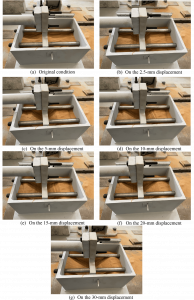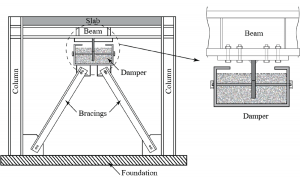
Sharjah University patents earthquake-resistant sand-based device
Sharjah University scientists invent a device of sand containers that can help buildings resist the force of seismic tremors in case of earthquakes.
SHARJAH, EMIRATE OF SHARJAH, UNITED ARAB EMIRATES, January 13, 2025 /EINPresswire.com/ -- Leon Barkho
The University of Sharjah has had a patent approved for the invention of a new device which can use sand containers to dissipate seismic attacks and protect buildings from harm in the event of an earthquake.
Seismic energy dissipation devices are not new, but the patent document (https://patents.google.com/patent/US12129682B2/en) describes the invention as unique since it merely relies on containers filled with sand or other granular material to protect a building’s structure from damage or failure during an earthquake.
Dissipation devices hitherto rely on steel and its yielding properties to help buildings withstand the power of seismic energy accompanying earthquakes. But the patent, according to its inventors, introduces what they describe as “an innovative energy dissipation device designed for seismic-resistant structures.”
The patent owners, Prof. Moussa Leblouba and Prof. Mostafa Zahri, have dubbed their discovery "Particle-Based Energy Dissipation Device." It employs natural granular materials like sand to mitigate the force of vibrations and dynamic seismic attacks earthquakes cause to buildings.
"Our work demonstrates the untapped potential of natural granular materials to provide an economical and reliable solution for seismic resistance," said Prof. Leblouba who filed the patent along with co-inventor Prof. Zahri. “Unlike conventional systems, it requires no external power and is highly cost-effective.”
According to the invention document, the device includes “a container, at least one movable plate, a slot, at least two holes, and at least two rods …The container includes a top plate that is horizontally slotted on the container. The container is made of a welded thick steel plate.
“Further, the container is filled with a granular material that is any one of a particle, sand, aggregates of different sizes, or steel balls with specific diameters. The container is of any size and shape that is anyone of a rectangular shape, a cuboid shape, among others.”
The device, according to the document, operates by absorbing and dissipating seismic energy through a specially designed container filled with granular material, namely sand. The natural properties of sand – or other granular materials – allow it to shift and compress under stress, effectively reducing vibrations.
“Through experimental studies, we demonstrated that the device improves energy dissipation efficiency and structural stability, making it an accessible solution for low-budget and retrofitted construction projects,” Prof. Leblouba added.
Drawings show how the granular material-based damper exhibited robust “hysteresis” behavior, dissipating significant amounts of energy. “The effective damping ratio was estimated to be between 37% and 75%, which is higher than many expensive passive damping systems.
“The dual configuration enhances stability and energy dissipation under medium-to-high loads. More silhouettes can, of course, be added to the device to achieve higher performance,” stressed Prof. Leblouba.
Hysteresis is a term which refers to a lag between input and output in a system once a change in direction occurs. In the event of an earthquake, vibrations trigger the device to spring into action and help buildings withstand the force of seismic attacks.
Dual configuration, in the context of the invention and related experiments, means the use of two silhouettes – that is rectangular steel plates that push the particles back and forth, with the option of adding more silhouettes if the design requires it.
The patent document mentions numerous systems invented to help buildings withstand the seismic impact of earthquakes. “These systems are categorized as active and passive control systems,” the document notes.
However, the document describes the currently available devices as “costly and hard to manufacture at any workshop.”
The document illustrates how the invention provides “a feasible energy dissipation device that is easily configured to suit a wide array of applications. This device is cheap, easy to manufacture at any workshop, and its constituting parts may easily be obtained from any hardware shop.
“Further, this device is capable to dissipate energy under small as well as large displacement amplitudes. Therefore, it is used for applications where small vibrations are anticipated (e.g., in buildings subjected to minor to moderate winds and man-made vibrations such as the case of train-induced vibrations) as well as in case of large vibrations (e.g., strong wind loads and strong earthquake ground motions).”
The document, according to Prof. Leblouba, sheds light on the invention’s economic feasibility, scalability, and simplicity. Leveraging inexpensive materials like sand “makes the device a cost-effective alternative to traditional seismic systems. Besides, the damper’s design is straightforward and suitable for both new and existing structures.”
The patent, granted by the United States Patent and Trademark Office, (https://patentcenter.uspto.gov/applications/18171051) has not yet been publicized for the industry stakeholders to get engaged with its practical implications. However, Prof. Leblouba is upbeat about the device’s future, predicting potential collaboration with civil engineering firms, municipalities, and disaster management agencies.
He maintained that the device’s ease of installation and maintenance makes it highly practical for diverse applications. He enumerated two major cost-effective and easy-to-do things like protecting buildings from earthquakes and wind-induced vibrations as well as retrofitting older structures in seismically active regions.
"This invention represents a significant leap forward in making earthquake protection accessible to communities worldwide, ensuring safety without compromising affordability.
"The results highlight the simplicity and effectiveness of using natural materials, proving that innovation doesn’t always have to come with a high price tag."
Co-inventor, Prof. Zahri, said the invention comes at a time of a critical need for devices with the ability to demonstrate resilience in an affordable and sustainable manner when earthquakes strike.
“Our invention provides a viable alternative to expensive seismic isolation systems, enabling wider adoption in regions with limited financial resources. The innovation not only enhances safety but also reduces maintenance costs, contributing to long-term structural integrity.”
LEON BARKHO
University Of Sharjah
+971 50 165 4376
email us here
Distribution channels: Building & Construction Industry, Emergency Services, Environment, Natural Disasters, World & Regional
Legal Disclaimer:
EIN Presswire provides this news content "as is" without warranty of any kind. We do not accept any responsibility or liability for the accuracy, content, images, videos, licenses, completeness, legality, or reliability of the information contained in this article. If you have any complaints or copyright issues related to this article, kindly contact the author above.
Submit your press release

